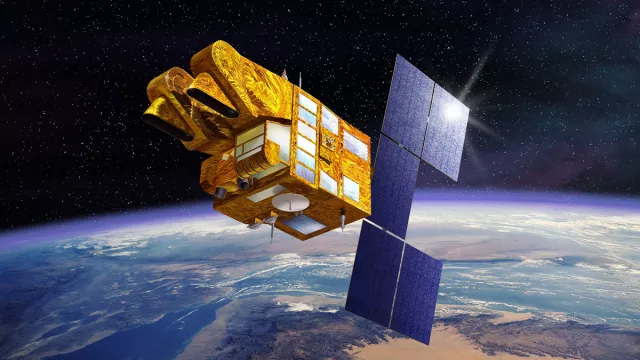Conceived and designed by CNES, the SPOT programme orbited seven satellites from 1986 onwards, revealing Earth’s surface in increasing detail and supporting a plethora of applications including mapping, monitoring of vegetation, land use and land cover, and studying the impacts of natural disasters.
Key information
| Mission | Mapping, digital terrain modelling, environmental monitoring |
|---|---|
| Domain | Earth observation |
| Launch date | First satellite launched 22 February 1986 |
| Partners | Airbus Defence & Space |
| Where | Near-polar, Sun-synchronous orbit, local equator crossing time 10:30 a.m. on descending orbit at an altitude of 830 km |
| Lifetime | SPOT-1: 17 years, SPOT-2: 19 years, SPOT-3: 3 years, SPOT-4: 15 years, SPOT-5: 13 years, SPOT-6: 10 years, SPOT 7: 10 years |
| Status | In operation (SPOT-6, SPOT-7), terminated (SPOT-1 to SPOT-5) |
Key figures
- 7 satellites in programme
- 1.5-m spatial resolution in black and white (SPOT-6 and SPOT-7)
- 6-m spatial resolution in colour (SPOT-6 and SPOT-7)
- 2 to 4 instruments depending on satellite
Key milestones
- 30 June 2014: SPOT-7 launched by PSLV
- 9 September 2012: SPOT-6 launched by PSLV
- 3 May 2002: SPOT-5 launched by Ariane 4
- 23 March 1998: SPOT-4 launched by Ariane 4
- 26 September 1993: SPOT-3 launched by Ariane 4
- 22 January 1990: SPOT-2 launched by Ariane 4
- 22 February 1986: SPOT-1 launched by Ariane 1
- February 1978: SPOT programme kicks off
Project in brief
Initiated in 1977 by France, SPOT was the first European Earth-observation satellite programme (SPOT comes from the French ‘Satellites Pour l’Observation de la Terre’). Between 1986 and 2002, five SPOT satellites were launched from Kourou. They subsequently delivered remarkable Earth imagery offering an excellent compromise between coverage—each image covers a square of 60 kilometres or 120 kilometres on a side—and ground resolution (10 metres for SPOT-1 to SPOT-4, 2.5 metres for SPOT-5).
This trail was first blazed by the United States in 1972 with the launch of Landsat-1. Where CNES innovated was in equipping the SPOT satellites with steerable mirrors to enable viewing on either side of the ground track, over a 950-kilometre swath, and to acquire imagery from different viewing angles for relief mapping, notably to generate digital terrain models.
In 1998, SPOT-4 was sent aloft with the first VEGETATION instrument, affording daily global coverage at a resolution of 1 kilometre for monitoring plant cover. In 2002, CNES equipped SPOT-5 with an instrument able to acquire near-simultaneous stereopair imagery, combined with a second VEGETATION instrument.
CNES brought the programme to a close when it de-orbited SPOT-5 in 2015, but Airbus Defence & Space continued the adventure with SPOT-6 and SPOT-7—launched in 2012 and 2014—leveraging the operational applications nurtured by their predecessors. At CNES, the SPOT programme has left a remarkable legacy with the Pleiades satellites, offering a ground resolution of 70 centimetres, and the Helios military intelligence satellites.
CNES’s role
The SPOT programme was conceived and designed by CNES.
Contacts
Continental Biosphere subject matter expert
Philippe Maisongrande
E-mail: philippe.maisongrande at cnes.fr


